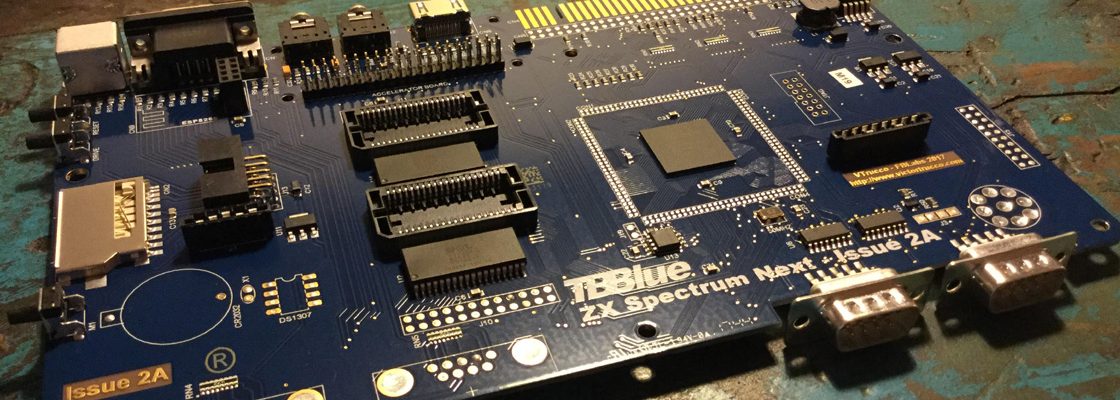Multiple FPGA Cores Support
How to install and use additional cores
Introduction
From v1.26, the firmware supports multiple additional cores installed in the
Next’s Flash memory, in slots 8..31 (slots 0..7 are reserved for anti-brick and standard Next cores).
Adding cores to the SD card
To make an additional core available to the firmware:
- Create a new subdirectory with an appropriate name under the c:/machines directory on the SD card. For example, a BBC Master core might best be housed in a directory called c:/machines/bbcmaster.
- Copy the core into the newly-created directory, naming it as core.bit.
- Optionally, create a text file named core.cfg in the same directory.
Add the following line to give the core a more descriptive name in the
firmware:name=BBC Master
(If this step is omitted, the firmware will use the directory name as the
core name).
Flashing and running cores
When you have added at least one additional core to the c:/machines directory, you can press C during a hard reset operation to start the additional cores module in the firmware.
This will bring up a list of the currently installed cores for slots 8..31. Navigate using the up, down, left, right cursor keys.
To install a core in a particular slot (or to erase a core from a slot) press SPACE. This will then list all currently-uninstalled cores found in the
c:/machines directory. Navigate to the desired core and press ENTER to flash it, or press SPACE to erase the current slot.
To run a core, navigate to the slot containing the desired core and press ENTER. This will start the core. If the core.bit file has been changed since the core was last flashed (an asterisk will be shown next to the slot number in this case) you will be asked if you want to upgrade it first.
Running a core from NextBASIC
A new dot command, .CORE, is provided to allow you to start a core from within NextBASIC. For example, use .CORE BBCMAS~1 (see note below) to start the core in the c:/machines/bbcmaster directory (provided it has been installed to your Next’s flash memory).
IMPORTANT NOTE!
If the core folder you chose is a long name, you will need to use an 8.3 compliant (short) name to start it with .CORE. For differences between long and short names refer to Chapter 20 of the ZX Spectrum Next User Manual.
Additional core configuration facilities
Core authors may take advantage of some additional facilities that the firmware provides, allowing resource files (such as ROMs or initialisation programs) to be loaded into SRAM before the core is started.
NOTE: A separation of ROMs and core will allow a core to be distributed with the ZX Spectrum Next’s distribution as SpecNext will not distribute software (a machine’s ROM(s) *IS* software) if express permission hasn’t been granted. As this isn’t usually the case with FPGA cores, if you’re a core author and you would like your core to be distributed, this condition needs to be met first!
Core configuration is controlled by the core.cfg file for each core. This is a plain text file. Each line may be a comment (preceded by ; ) or one of the following:
name=CORE NAME
; Sets the displayed name of the core in the firmware cores module
; (if not present, the directory name containing the core is used)
; eg
; name=Acorn BBC Master
resource=FILE,PAGE
; Loads a resource file (eg a required ROM or core initialisation program)
; into SRAM beginning at the 16K SRAM page specified. The file must be
; in the "machines/corename" directory.
; Any number of resource files may be specified.
; eg
; resource=boot.rom,20
userfile=SUBDIR,DESCRIPTION,PAGE,FLAGS,OFFSET
; Requests the user to select a file to be loaded into SRAM. The files
; to be chosen from are located in the "machines/corename/SUBDIR" directory
; and the user will be asked to select a "DESCRIPTION".
;
; The selected file will be loaded into SRAM beginning at the 16K SRAM page
; specified in PAGE.
;
; FLAGS & OFFSET are optional parameters.
;
; If FLAGS bit 0 is set, then the user is forced to select a file; if not,
; then they may opt to not select a file (by pressing SPACE).
;
; If FLAGS bit 1 is set, then the file is not loaded into SRAM. Instead,
; the selected filename is written to the SRAM page selected at the optional
; offset given by OFFSET.
;
; Any number of user files may be specified.
;
; eg
; userfile=GAMEROMS,game,30,1
config=PAGE,OFFSET
; If this option is present, the firmware will write some configuration
; information into the SRAM page selected at the optional offset.
;
; The first 16 bytes contain generic configuration information (taken from
; the Next's config.ini) that the core may optionally take into account
; when starting:
; +0 video timing mode (0..7)
; +1 scandoubler (0=off, 1=on)
; +2 frequency (0=50Hz, 1=60Hz)
; +3 PS/2 mode (0=keyboard, 1=mouse)
; +4 scanline weight (0=off, 1=75%, 2=50%, 3=25%)
; +5 internal speaker (0=disabled, 1=enabled)
; +6 HDMI sound (0=disabled, 1=enabled)
; +7..15 RESERVED
;
; The next 16 bytes indicate whether the first 16 "userfile" options resulted
; in a file being selected. For each byte, 0 means "not selected" and 1 means
; "selected".
;
; The next 32 bytes contain the null-terminated path of the core
; (eg "/MACHINES/CORENAME",0)
;
; The next 192 bytes are reserved for future use.
;
; eg
; config=32
SRAM Page Numbers
The SRAM page numbers provided in the core.cfg file may be between 0 and 31, corresponding to the first 512K of SRAM.
Note that pages 16, 18 and 21 should NOT be selected as this RAM is used by the firmware.

